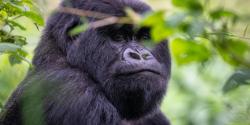Red pandas get their name from their food of choice—panda means “bamboo-eater”.
They were named “panda” roughly fifty years before giant pandas and are not closely related.
Scientific Name: Ailurus fulgens
Conservation Status: Endangered
Size: Body length ranges from 20 to 25 inches, with very long tails ranging from 11 to 19 inches.
Weight: Average of 15 pounds
Median Life Expectancy: 10.4 years













